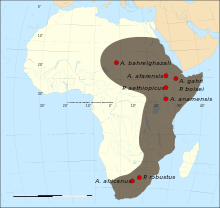
Back Australopithecus Afrikaans قرد جنوبي Arabic أوسطرالوپيتيك ARY اوسترالوبيثيكوس ARZ Australopithecus AST Avstralopitek Azerbaijani Australopithecus BCL Аўстралапітэкі Byelorussian Австралопитеци Bulgarian ལྷོ་སྤྲ། Tibetan
| Australopithecus Temporal range: Pliocene
| |
|---|---|

| |
| Australopithecus afarensis | |
| Scientific classification | |
| Kingdom: | |
| Phylum: | |
| Class: | |
| Order: | |
| Family: | |
| Genus: | Australopithecus R.A. Dart, 1925
|
| Species | |

Australopithecus[1] is a genus of extinct hominids closely related to humans.
The first Australopithecus described was the Taung Child, discovered by Raymond Dart, and described in 1925.
Their remains are mostly found in East Africa, and the first fossil is from 3.9 million years ago (mya). The split from other apes would have taken place earlier, perhaps about 5 mya.
It is widely believed that the group of which they are part gave rise to the genus Homo, and hence to human beings.[2]
The genus Australopithecus originally included two rather different forms. One form was lightweight: the gracile australopithecines. The other form was bulkier, the robust australopithecines.
It is still under discussion whether they should be put in separate genera. Here we treat the gracile forms; the robust forms are described elsewhere as Paranthropus.
Gracile australopithecines shared several traits with modern apes and humans. They were widespread throughout Eastern and Northern Africa 3.9 to 3 million years ago.